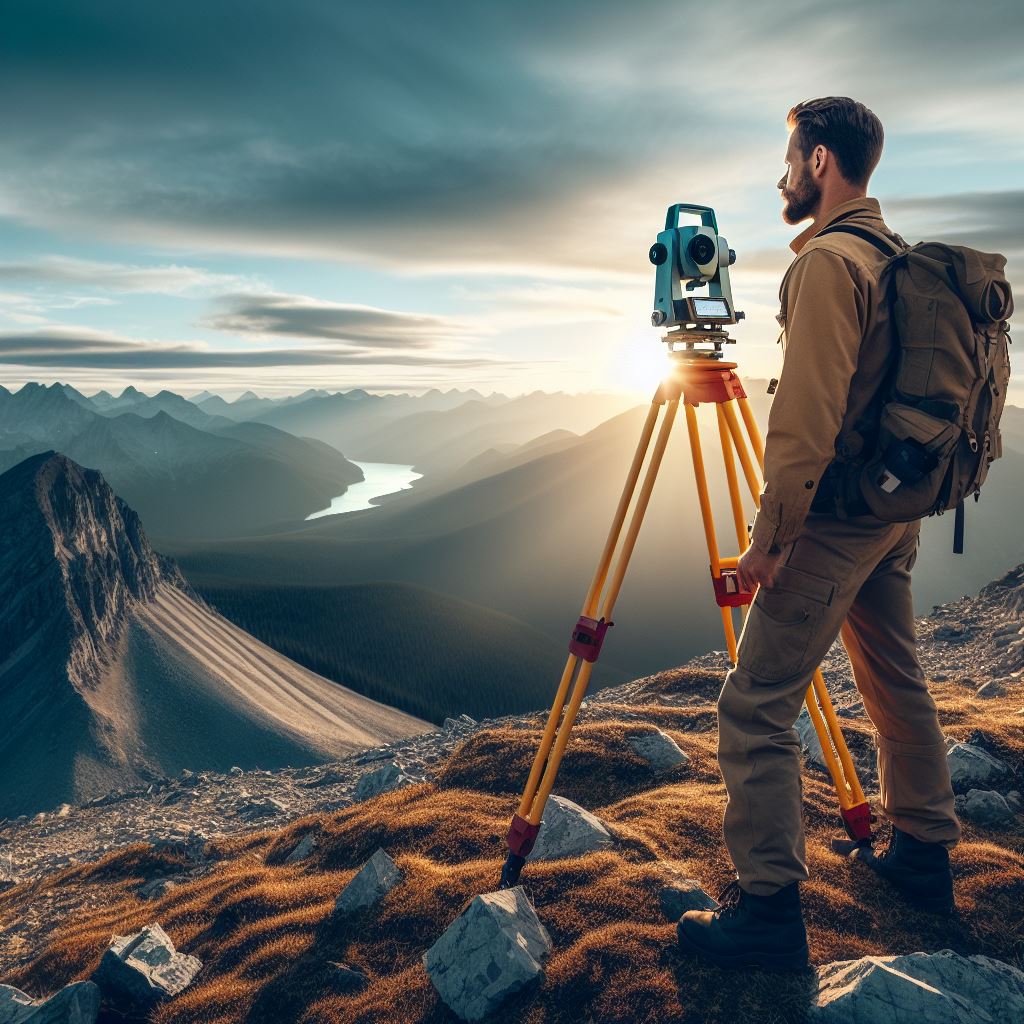Introduction
Geographic Information Systems (GIS) and surveying play a vital role in various industries and sectors across Canada.
These practices are essential for collecting and analyzing spatial data, which is crucial for decision-making and planning.
This blog post aims to delve into the evolving practices of GIS and surveying in Canada and examine their impact on different fields.
Geographic Information Systems and surveying have become indispensable tools in industries such as urban planning, natural resource management, and transportation.
In urban planning, GIS helps in analyzing demographic data, land use patterns, and infrastructure development.
It enables better decision-making for future urban growth.
Furthermore, GIS and surveying are also extensively used in natural resource management.
By mapping the location of natural resources, such as forests and minerals, these practices help in resource conservation, sustainable development, and environmental impact assessment.
Moreover, the transportation sector greatly benefits from GIS and surveying.
These practices assist in optimizing transportation networks, identifying potential road hazards, and implementing efficient route planning.
Thesis statement: This blog post will investigate the evolving practices of GIS and surveying in Canada and assess their influence on various fields.
From urban planning to natural resource management and transportation, GIS and surveying are transforming how these industries operate and make informed decisions.
To understand the magnitude of the impact of GIS and surveying practices in Canada, it is crucial to explore their applications and advancements within different sectors.
This blog post will highlight specific case studies and examples to demonstrate the significance and evolution of GIS and surveying in Canada.
Stay tuned for the following sections, where we will delve deeper into the different industries and sectors and how GIS and surveying are shaping their practices.
Overview of GIS and Surveying in Canada
Define GIS and surveying and briefly explain their key concepts
GIS (Geographic Information System) is a system that allows for the capture, storage, analysis, and presentation of geographically referenced data.
It involves the integration of various data sources and allows for spatial analysis and visualization.
Surveying, on the other hand, is the process of measuring and mapping the Earth’s surface.
It involves the determination of boundaries, distances, and elevations of both natural and man-made features.
The historical background of GIS and surveying in Canada
In Canada, GIS and surveying have a rich historical background. The Indigenous peoples of Canada have long used their knowledge of the land to navigate and understand its resources.
The arrival of European settlers brought new surveying techniques, which were used to establish land ownership and boundaries.
The role of technology advancements in the evolution of these practices
Technology advancements have played a significant role in the evolution of GIS and surveying practices in Canada.
In the past, surveyors relied on manual methods such as chains and compasses.
However, the introduction of electronic distance measuring devices and Global Positioning Systems (GPS) revolutionized surveying, allowing for more accurate and efficient data collection.
Similarly, GIS technology has evolved from simple computer-based mapping to sophisticated systems that can integrate various data sources and perform complex spatial analysis.
Unlock Your Career Potential
Visualize a clear path to success with our tailored Career Consulting service. Personalized insights in just 1-3 days.
Get StartedThe availability of high-resolution satellite imagery and LiDAR data has further enhanced the capabilities of GIS in Canada.
The growing demand for professionals skilled in GIS and surveying in the country
These advancements have led to a growing demand for professionals skilled in GIS and surveying in Canada.
The ability to collect, manage, and analyze spatial data has become crucial in various industries, including urban planning, natural resource management, transportation, and emergency response.
Furthermore, the role of GIS and surveying has expanded beyond traditional applications.
They are now being used in innovative ways, such as in the development of smart cities, where geospatial data is used to optimize infrastructure and manage resources efficiently.
In short, GIS and surveying have evolved significantly in Canada due to technology advancements.
These practices have become essential in various industries, and the demand for skilled professionals continues to grow.
The rich historical background and the integration of indigenous knowledge make Canada a unique and exciting place for GIS and surveying.
Read: Surveying Equipment: A Canadian Buyer’s Guide
Applications of GIS and Surveying in Canada
GIS (Geographic Information System) and surveying are two crucial tools that are widely used in various industries and sectors in Canada to gather and analyze geographic data.
They play a significant role in urban planning, environmental management, transportation, agriculture, and natural resource sectors.
Industries and Sectors Relying on GIS and Surveying in Canada
Several industries in Canada heavily rely on GIS and surveying to obtain accurate geospatial data.
These industries include:
- Oil and Gas: GIS and surveying are used to locate potential drilling sites, monitor pipeline networks, and manage environmental impacts.
- Telecommunications: GIS is utilized in the planning and maintenance of communication networks, tower placements, and coverage analysis.
- Mining: GIS and surveying help in identifying mineral deposits, managing mining operations, and ensuring compliance with environmental regulations.
- Construction: These tools assist in site selection, land-use planning, and site development for construction projects.
- Forestry: GIS and surveying are used to map and manage forest resources, plan timber harvesting, and monitor forest health.
GIS and Surveying in Urban Planning and Development
In urban planning and development, GIS and surveying are extensively employed to gather data, analyze trends, and make informed decisions.
They help in:
- Land-Use Planning: GIS is used to identify suitable locations for housing, infrastructure development, and commercial areas.
- Transportation Planning: These tools assist in designing efficient transportation networks, optimizing traffic flow, and identifying areas of congestion.
- Infrastructure Management: GIS and surveying enable the efficient management of utilities such as water, sewer, and electricity networks.
- Disaster Management: GIS helps in identifying areas susceptible to natural hazards, planning evacuation routes, and assessing the impact of disasters.
GIS and Surveying in Environmental Management and Conservation Efforts
GIS and surveying play a crucial role in managing and conserving Canada’s diverse ecosystems and natural resources. They are used for:
- Environmental Monitoring: GIS enables the tracking and monitoring of environmental changes, such as deforestation, land degradation, and pollution levels.
- Habitat Mapping: These tools help in mapping and analyzing habitats for endangered species, facilitating conservation planning and management.
- Water Resource Management: GIS and surveying aid in mapping watersheds, monitoring water quality, and managing water resources sustainably.
- Climate Change Analysis: GIS is employed to assess the impact of climate change on ecosystems, identify vulnerable areas, and plan adaptation strategies.
Significance of GIS and Surveying in Transportation, Agriculture, and Natural Resource Sectors
GIS and surveying are vital in the transportation, agriculture, and natural resource sectors in Canada:
- Transportation: These tools are used in route planning, traffic management, asset tracking, and optimizing logistics in the transportation sector.
- Agriculture: GIS and surveying assist in precision farming, crop yield prediction, soil analysis, and optimized irrigation planning.
- Natural Resource Management: GIS and surveying aid in mapping and monitoring natural resources such as forests, wildlife habitats, and water bodies.
In fact, GIS and surveying are versatile tools extensively utilized in Canada across various industries and sectors.
They play a crucial role in urban planning, environmental management, transportation, agriculture, and natural resource sectors, contributing to informed decision-making and sustainable development.
Read: Marine Surveying in Canada: Roles and Responsibilities

Technological Innovations in GIS and Surveying
The latest technological advancements in GIS and surveying in Canada
GIS (Geographic Information System) and surveying practices in Canada have witnessed significant advancements with the integration of new technologies.
These innovations have revolutionized the way data is collected, analyzed, and utilized, resulting in more efficient and accurate results.
This blog section explores the latest technological advancements in GIS and surveying in Canada, including the use of remote sensing, LiDAR, and satellite imagery, as well as the integration of GIS with augmented reality and artificial intelligence.
Remote Sensing, LiDAR, and Satellite Imagery
Remote sensing technologies, such as aerial photography and satellite imagery, have greatly enhanced GIS and surveying practices in Canada.
These technologies provide high-resolution images and topographic data, enabling better visualization and analysis of geographical features.
LiDAR (Light Detection and Ranging) is a remote sensing technology that uses laser pulses to measure distances, creating highly accurate 3D representations of the Earth’s surface.
With LiDAR and satellite imagery, professionals can quickly and accurately map terrains, identify land features, and monitor changes over time.
Integration of GIS with Other Technologies
GIS has become more powerful and versatile with the integration of other technologies such as augmented reality (AR) and artificial intelligence (AI).
AR technologies, such as interactive maps and virtual reality headsets, allow users to visualize GIS data in real-time and superimpose it on the physical environment.
This integration enhances the decision-making process by providing users with immersive and interactive experiences.
AI algorithms and machine learning techniques enable GIS systems to automatically analyze and interpret large datasets, detect patterns, and make predictions.
The integration of GIS with AI ensures more accurate analysis and faster data processing.
Benefits and Challenges Associated with Adopting New Technologies
Benefits Associated with Adopting New Technologies
The adoption of new technologies in GIS and surveying practices offers various benefits, but it also comes with challenges.
The benefits include:
- Increased efficiency and accuracy in data collection and analysis.
- Enhanced visualization and understanding of geographical data.
- Improved decision-making with real-time information.
- Faster data processing and analysis with AI integration.
- Cost savings through the use of remote sensing technologies.
Challenges that come with adopting these new technologies
Despite the numerous advantages, there are also challenges that come with adopting these new technologies:
- High initial costs of acquiring and implementing the technologies.
- Training and capacity building required to use the technologies effectively.
- Data privacy and security concerns with the use of AI and remote sensing technologies.
- Integration and compatibility issues with existing GIS systems.
- Limited availability of high-quality satellite imagery in remote areas.
In essence, the technological advancements in GIS and surveying practices in Canada have greatly improved the efficiency and accuracy of data collection, analysis, and visualization.
The integration of remote sensing, LiDAR, satellite imagery, augmented reality, and artificial intelligence has opened up new possibilities for professionals in these fields.
However, the adoption of these technologies also brings challenges that need to be addressed in order to fully leverage their benefits.
As technology continues to evolve, it is crucial for GIS and surveying professionals to stay updated and adapt to the changing landscape of their industry.
Read: Navigating Surveyor Career Paths in Canada
Skills and Education in GIS and Surveying
As the field of GIS and surveying continues to evolve, there are specific skills that professionals in this industry need to excel.
Additionally, having the right education and training is crucial for a successful career in GIS and surveying in Canada.
Specific Skills Required
- Proficiency in geospatial technologies such as GPS, remote sensing, and GIS software.
- Strong analytical and problem-solving skills to interpret and manipulate geographic data.
- Excellent communication skills to effectively convey complex information to clients and stakeholders.
- Attention to detail and ability to conduct precise measurements and calculations.
- Knowledge of land surveying principles and techniques.
- Ability to work both independently and in a team environment.
Educational Pathways and Training Programs
In Canada, there are various educational pathways and training programs available for individuals interested in pursuing a career in GIS and surveying.
Some of the options include:
- Bachelor’s degree programs in geomatics or surveying engineering at universities.
- College diploma programs in GIS and geomatics technologies.
- Professional training courses and workshops offered by industry organizations.
Continuous Learning and Professional Development
Continuous learning and professional development are essential in the rapidly evolving field of GIS and surveying.
Staying updated with the latest technologies and industry trends is crucial to remain competitive.
Professionals can engage in:
- Attending conferences, seminars, and webinars to gain new insights and network with industry experts.
- Participating in online courses and certifications to enhance skills and knowledge.
- Joining professional associations to access resources, mentorship, and networking opportunities.
Professional Associations and Certifications
There are several professional associations and certifications in Canada that are relevant to GIS and surveying professionals. Some of these include:
- The Canadian Institute of Geomatics (CIG) offers various membership options and organizes conferences and workshops.
- The Association of Canada Land Surveyors (ACLS) provides certification and sets professional standards for land surveyors.
- The Geographic Information Systems Certification Institute (GISCI) offers certifications for GIS professionals.
- The Professional Surveyors Canada (PSC) represents and advocates for professional land surveyors in Canada.
In a nutshell, excelling in GIS and surveying professions requires specific skills, continuous learning, and the right education.
Canada offers various educational pathways, training programs, professional associations, and certifications to support professionals in this field.
Read: Canadian Surveyors’ Biggest Challenges in 2024
Conclusion
This blog post has explored the evolving practices of GIS and surveying in Canada.
We have discussed how GIS technology has revolutionized data collection and analysis in various industries.
The significance of GIS and surveying in Canada’s evolving practices cannot be overstated.
These technologies have enabled more accurate mapping, better urban planning, and improved resource management.
They play a crucial role in decision-making processes across multiple sectors.
Looking ahead, there are exciting future developments and opportunities in the field of GIS and surveying.
With advancements in technology, such as the integration of AI and remote sensing, we can expect even more sophisticated data collection and analysis techniques.
We encourage readers to explore careers and educational pathways in GIS and surveying.
Moreover, as the demand for professionals in this field continues to grow, there are ample opportunities to contribute to Canada’s evolving practices and make a meaningful impact on society.
As we wrap up this blog section, we hope that you have gained a better understanding of the importance of GIS and surveying in Canada.
We encourage you to continue exploring this fascinating field and stay updated with the latest advancements in technology.
Together, we can shape the future of GIS and surveying in Canada and beyond.




